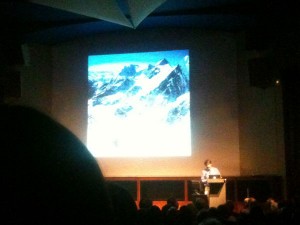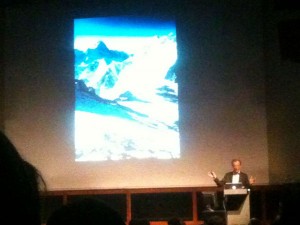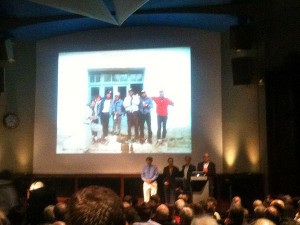In 1988 a ragtag quartet of mountaineers from the USA, Canada and the UK made one of Everest’s most intrepid ascents, and last Thursday I had the good fortune of attending a lecture at the Royal Geographical Society (RGS) in London celebrating the 25th anniversary of their climb.
Everest’s gigantic east or Kangshung Face had only been climbed once when expedition leader Robert Anderson set about putting a team together, and never by the route they chose to take, arriving on the South Col from the opposite direction most climbers do, and taking the standard route up the Southeast Ridge from there. Stephen Venables became the first Briton to climb Everest without supplementary oxygen, and his effectively solo ascent involved an unplanned overnight bivouac below the South Summit and ranks as one of the more remarkable achievements in the mountain’s history.
Nearly all the team reunited for the anniversary, and the format for the lecture was an original one, with different members taking up the narrative for each stage of their journey. Robert himself led off with a description of how he came to plan the expedition and assemble the team. Because of the steepness of the Kangshung Face they decided to climb without Sherpa support, which meant they had to do their own load carrying. A logical consequence of this meant they climbed without oxygen, since at the time a cylinder of oxygen weighed up to 10kg. It was the 35th anniversary of Everest’s first ascent, and one of his sponsors suggested he consult Sir John Hunt, leader of that original British expedition. Hunt agreed to give their attempt his blessing if Robert took along Englishman Stephen Venables with his fellow American Ed Webster, and the Canadian Paul Teare.
Robert certainly has some gift for persuasion. As well as Hunt he consulted Everest legend Sir Edmund Hillary about the adventure, and succeeded in inviting Tenzing Norbu, the son of Hillary’s companion on that first ascent, Tenzing Norgay. During his talk Robert came across as a brash and wise-cracking Coloradan, which was a surprise to me. He was my expedition leader when I attempted Cho Oyu a few years ago, and he was not at all like his stage persona. While he certainly had a dry sense of humour lurking beneath the surface, he was much more laid back and radiated a quiet authority. I said to one of my Cho Oyu team mates, whom I bumped into in the bar at the lecture, that I don’t remember him telling so many jokes (that was usually my job, though on this evidence Robert’s are definitely funnier than mine).

He handed over to Tenzing Norbu, who provided a Sherpa perspective of the expedition, and took us through their time at base camp.
“I have many stories about these people,” he said, “but like a mosquito in a nudist colony, I don’t know where to begin.”
Norbu has lived most of his life in the US and never had any intention of climbing the mountain. He went on to explain that while twelve members of his family have now climbed Everest, he isn’t one of them.
Ed Webster took us through the most difficult and dangerous part of their climb, from base camp up the Kangshung Face to the South Col. At its highest point the face rises a breathtaking 3350m above the Kangshung Glacier, and even by the route the team took up to the South Col it was nearly 2500m. Ed turned out to be quite an eccentric, excitable character, who might have made a career of it in the performance arts had he not chosen to become a mountaineer. Halfway up the face was a 100 foot crevasse he and Robert needed to climb down into and up the other side. While they were at the bottom they heard a rumble, and looked up to see hundreds of tons of ice crashing down towards them.
“‘Ed, Ed, are you alright?’ I heard Robert screaming at me,” said Ed as he screamed into the microphone.
“‘Robert, Robert, I’m OK. I’m standing right next to you,’ I screamed back at him. We cowered in the crevasse as the ice tumbled past us with the sound of an aircraft flying overhead. Then all of a sudden it was quiet,” Ed continued.
“‘Phew, I think it’s safe now,’ Robert said to me. ‘Now if you go stand over there I’ll take your photo.'”
By this stage Ed was out of breath, like he’d been climbing a mountain there and then, and this particular performance was greeted with a round of applause. Later his presentation became even more eccentric when he decided to act out the laboured breathing of a climber at high altitude. He did his best Dustin Hoffman impression (or replace with the name of your favourite actor) gasping eight exhausted breaths like a dying man drawing his last, taking two small steps forward, then gasping eight more exhausted breaths. We didn’t know what to make of it. It looked like he was about to pass out on stage, but there were a few sympathetic chuckles from the handful of members of the audience on Ed’s wavelength. I don’t know what he drinks, but I’d like to try some.

The team reached the South Col and camped the night there. It was windy when they arrived, and Ed’s photos showed a horrendous suicidal lenticular cloud over the Southeast Ridge just a few metres above them. By the morning the weather had improved, and they realised they had a chance at the summit, but there was a new problem. Paul Teare was in the early stages of high altitude cerebral edema (HACE), and they had to get him down. Robert walked over to Ed’s and Stephen’s tent and asked one of them to escort him back down the Kangshung Face. Interestingly, they were both about to volunteer.
“I knew Stephen was much stronger than I was,” said Ed. “If any of us was going to reach the summit, it would be him.”
“It was their expedition,” said Stephen. “They had done all the organising before they invited me along, and I felt like I was tagging along for the ride. If anyone was going to go down with Paul it had to be me.”
While they were discussing it Paul had packed his rucksack, lifted it onto his shoulders and walked over to them.
“I can make it on my own if I leave now,” he said. “I don’t want any of you to sacrifice your summit for me.” Then he turned and left.
Earlier in his talk Ed said what a happy team they were. Although they hardly knew each other before they set out on the expedition, they got along extremely well, in marked contrast to other Everest expeditions which had become famous for high profile climbers bickering amongst themselves.
“People often tell me how brave we must have been,” said Stephen, “but there was only one truly brave decision made on that expedition, and that was Paul’s decision to descend alone.”

Stephen took up the story of their summit ascent. They set off during darkness in the days before commercial expeditions to Everest. They were the only people there, and there were no fixed ropes and lines of climbers’ head torches to guide them up the Southeast Ridge. They didn’t know the way, and struck off up a random gully. Even when the sun arose they were unsure of the best line, with no footprints of others who had been that way. Ed took many photographs to document their journey, and was alert enough to note the presence of an abandoned tent from a Japanese expedition some distance above the South Col. Meanwhile Stephen was breaking trail practically the whole way, but still managing to pull away from Ed and Robert. Somewhere above the col, the standard trail diverts to the right to join the ridge at a flattish area known as The Balcony. Stephen wasn’t aware of this and took a steeper, more direct line which joined the ridge much higher up.
“I kept expecting to join the ridge, but the slope seemed to continue endlessly,” he said. “I looked back to see if the others knew where we were, but they were blithely following me up the Venables Direct Route.”
He continued onwards, onto the ridge and over the South Summit, gradually pulling away from his companions.
“Before the expedition began I thought we maybe had a 10% chance of being successful. Somewhere during our climb of the Kangshung Face and onto the South Col I put our chances at 50/50. Only after I climbed the Hillary Step did I know I was going to succeed.”
It was late by the time he reached the summit, and the weather was worsening. His only record of it is a photo of the ground, containing an assortment of flags and a discarded oxygen cylinder. By then Robert and Ed had already turned around, and made it as far as the abandoned Japanese tent before darkness fell. Stephen managed to descend past the South Summit before bivouacking somewhere on the Southeast Ridge. He was exhausted and hallucinating.
“Eric Shipton [the great mountain explorer] came to visit me and asked if I was OK,” he said.
By morning he was still alive and made his way wearily down to the South Col. On the way he noticed two figures emerging from an old tent on the slopes below him.
“I expect that will be Mallory and Irvine,” he said to himself.

Robert and Ed were very surprised to look up and see someone staggering towards them. They were certain Stephen must be dead, and knew they were in no position to go up and look for him.
They waited for him and descended together. They spent the next night at their old Camp 2 on a ledge beneath an overhanging section of ice halfway up the Kangshung Face. On the way up they had considered it to be a safe location because the overhang provided some protection against avalanches, but when they set off to climb the following morning they noticed a giant crack across it. The overhang wasn’t safe, and could have collapsed on top of them at any moment. They made a mental note not to stay there again on the way down, but now they were too exhausted to do otherwise, and the nature of their ascent may well have made them more accepting of risk.
“You may have realised by now that Ed has a talent for melodrama,” said Stephen. “The following morning he looked out of the tent and announced, ‘if we don’t leave right now then'” [deep voice] “‘we’re all gonna die!'”
They made it safely back to base camp where they found Paul Teare, who had recovered from his cerebral edema. They were not unscathed. Stephen’s night in the cold meant he lost three toes to frostbite. Ed fared rather worse, he had taken some unbelievable photographs to document their climb, but they came at a cost, and he lost the tips of all his fingers. But happily 25 years later they are all still very much alive, including Paul, who climbed up on stage to take a bow with his three companions. Their whole performance had taken just an hour and a half, but it was the fastest hour and a half I’ve had in a long time. I don’t go to the cinema very often, but frankly who needs to when you’ve got the RGS down the road, and can hear about much more exciting real life dramas like this every once in a while.







Those guys were bonkers! – and very luck! 🙂
Wow Mark, what an adventure! I would have loved to see Mads in full party mode that night 😉 Who else did you bump into from Cho?
Cheers, Dean. Matt, Mark P and Richard S were all in the bar before the gig.
Sounds like a great night was had by all. Would have loved to be present. Cheers Kate